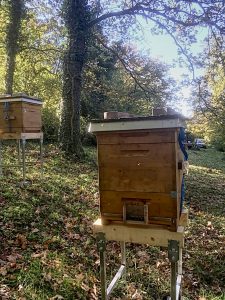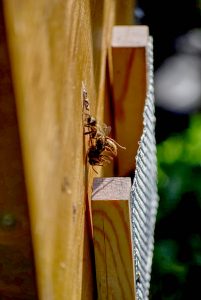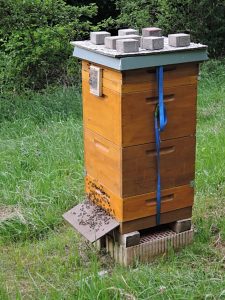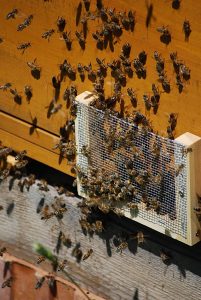Sibylle Kempf from Germany gives her thoughts about the use of robber screens when helping the bees to develop Varroa resistance. The apiary above where the hives are very close to each other is not one of hers. (If you don’t see the picture click on the headline so you arrive at the page with only this post.) The picture shows a common way to place hives in Germany. It’s better if you can place them much further apart:
In nature, the bees would never live close to each other. To live as close as is often the case in our apiaries promotes disease and mite transmission and there will be big difficulties to find out which one are the better for making splits or queen breeding.
 My hives are spaced quite far apart compared to how many do it in Germany
My hives are spaced quite far apart compared to how many do it in Germany
Since none of us where I live have big areas for ourselves available, we have to think what would be helpful to avoid the drawbacks this create. I think a setup with a few meters distance and the entrances in different directions helps a lot.
In addition, you can use devices to hinder robbery, obvious strong robbery, and so called silent robbery that you have hard times to discover, but can cause a lot of so called reinvasion of mites. Small entrances and a robber screen all year round have had no disadvantages to the air conditioning and traffic of my colonies even with so called closed boards (not screened bottom boards). Also I have seen that the bees have had no problems to pull out the dead, as you can see in the hornet picture.
When making a queen cell finisher after grafting, you can use the robber screen on an extra entrance above the queen excluder for the drones which will follow the brood frames moved up there.
So you can easily put on the box on the excluder for a finisher without shaking off the bees. The bees can protect the honey easier from robbers with the robber screen on.
I calculate that drifting is prevented by about 40% with this robber screen in place. I estimated this when comparing the lighter colored elgon bees with my grey carniolans. Not much mixing at all between the colonies, not even the drones drifted.
The robbery within the apiary is completely prevented, so it is also possible to place weak colonies, e.g. nucs and splits, very well protected.
If all beekeepers would use robber screens, it would also hinder my bees to rob hives of other beekeepers and thus hinder the spread of mites through reinvasion.
The only downside I have found is that bees could be easier taken by hornets and dragonflies. Sometimes they did not fly out, but stayed behind the screen when a hornet was hunting. But if the hornet went in, then the bees surrounded it and killed it.
I think I will put the screens with the openings sideways this coming season, to make it easier for the bees to leave return.
 The bees have killed a hornet that have dared to enter the hive. They have no problem getting rid and clean the hive of the dead hornet.
The bees have killed a hornet that have dared to enter the hive. They have no problem getting rid and clean the hive of the dead hornet.
